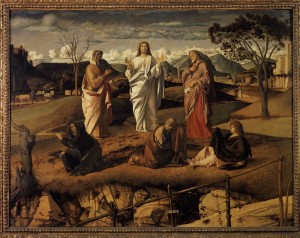On the mountain You were transfigured, O Christ God, and Your disciples beheld Your glory as far as they could see it; so that when they would behold You crucified, they would understand that Your suffering was voluntary, and would proclaim to the world that You are truly the Radiance of the Father (Kontakion for the Transfiguration).
The Transfiguration of Our Lord, as testified to in Divine Revelation shows us our ultimate destiny as Christians: the ultimate destiny of all men and all creation to be transformed and glorified by the splendor of God Himself.
On the feast of the Transfiguration on August 6th, is a summer celebration and expectation of Great Lent, of the Eucharist, the Cross, and the Resurrection. The Church blesses grapes, as well as other fruits, on the Transfiguration is a beautiful sign of our final transfiguration of all things in Jesus Christ. We bless grapes because we bless God! The gesture of bringing and blessing of grapes points to the ultimate flowering and fruitfulness (generativity) of all creation in the Paradise; here we all will be transformed in the garden by the glory of the Lord.
Bunches of grapes are symbols of completion —especially experienced in the completion of the growing season— which has finally brought things to fruition. Christians see in the grapes the biblical image of Jesus as the Vine.
In the Bible we read of the custom of bringing fruit to the temple for consecration (Genesis 4:2-4; Ex 13:12-13; Numbers 15:19-21; Deuteronomy 8:10-14). In the New Testament the 12 Apostles brought this tradition to the Church (1 Corinthians 16:1-2). Later in the early centuries of Christianity, the faithful brought to the Church fruits and vegetables of the new harvest: bread, wine, oil, incense, wax, honey, etc. Some of the offerings were taken to the altar, and the balance made available to needs of the clergy and the poor.
Hence, grapes ought to remind us that by our life we are known for our service to others. Thus, the grapes remind us that we should not be sour grapes for others.
 At the conclusion of the Divine Liturgy for the feast of the Transfiguration of the Lord, Father Iura (St. Michael the Archangel Ukrainian Catholic Church, New Haven, CT) blessed grapes, harvested fruits and vegetables and honey.
At the conclusion of the Divine Liturgy for the feast of the Transfiguration of the Lord, Father Iura (St. Michael the Archangel Ukrainian Catholic Church, New Haven, CT) blessed grapes, harvested fruits and vegetables and honey.






